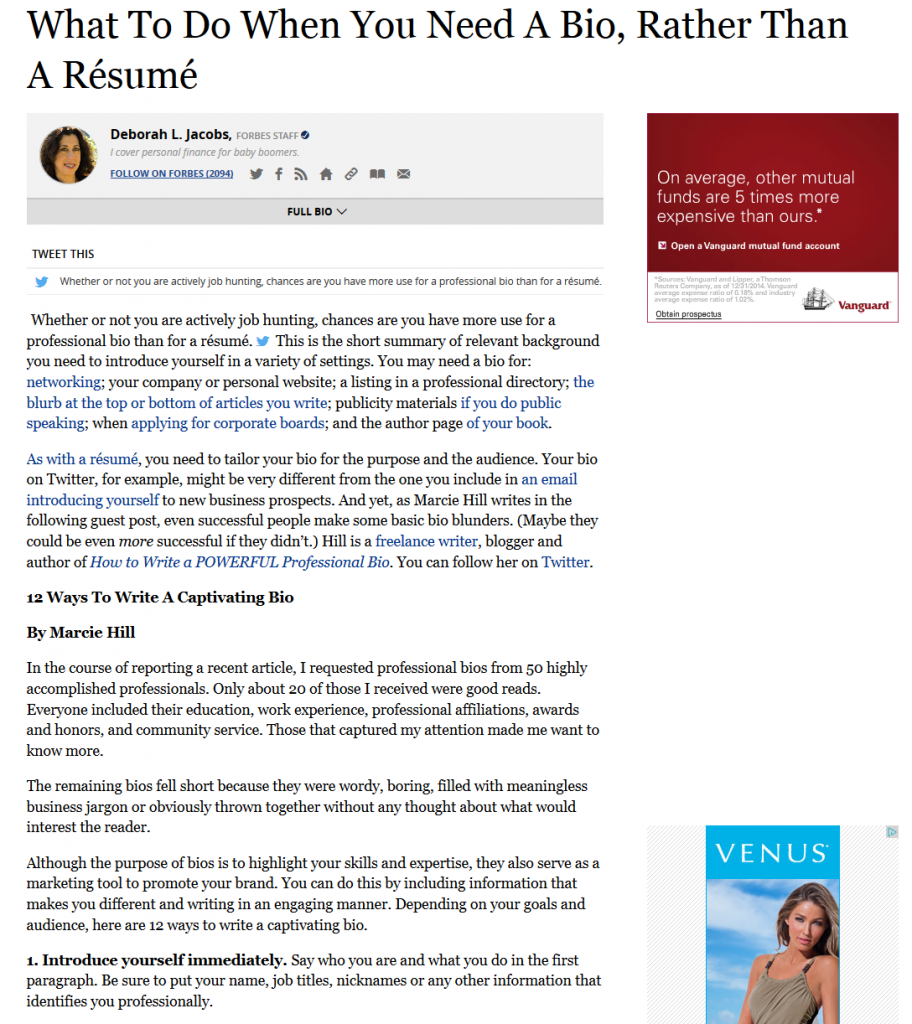This article was originally posted on Forbes.com by Deborah Jacobs on June, 3, 2014.
Whether or not you are actively job hunting, chances are you have more use for a professional bio than for a résumé. This is the short summary of relevant background you need to introduce yourself in a variety of settings. You may need a bio for: networking; your company or personal website; a listing in a professional directory; the blurb at the top or bottom of articles you write; publicity materials if you do public speaking; when applying for corporate boards; and the author page of your book.
As with a résumé, you need to tailor your bio for the purpose and the audience. Your bio on Twitter, for example, might be very different from the one you include in an email introducing yourself to new business prospects. And yet, as Marcie Hill writes in the following guest post, even successful people make some basic bio blunders. (Maybe they could be even more successful if they didn’t.) Hill is a freelance writer, blogger and author of How to Write a POWERFUL Professional Bio. You can follow her on Twitter.
12 Ways To Write A Captivating Bio
By Marcie Hill
In the course of reporting a recent article, I requested professional bios from 50 highly accomplished professionals. Only about 20 of those I received were good reads. Everyone included their education, work experience, professional affiliations, awards and honors, and community service. Those that captured my attention made me want to know more.
Although the purpose of bios is to highlight your skills and expertise, they also serve as a marketing tool to promote your brand. You can do this by including information that makes you different and writing in an engaging manner. Depending on your goals and audience, here are 12 ways to write a captivating bio.
1. Introduce yourself immediately. Say who you are and what you do in the first paragraph. Be sure to put your name, job titles, nicknames or any other information that identifies you professionally.
Example:
Paul Hall, also known as the “Main Money Man,” is an investment banker and radio host.
2. Tell your story. Share how personal and professional situations have changed your life or built your character. Explain how you overcame adversities, challenges and obstacles. Relay your personal and professional mission or message. Honor your role models or supporters who helped you on your journey to success.
Examples:
After being laid off from my job, I enrolled in culinary classes to pursue my joy of cooking.
Whenever I got discouraged in my studies, the words of my favorite high school science teacher kept me grounded, which is how I made it through college.
3. Quantify your results. Use numbers to show how you save time and money, and how you earned money.
Examples:
Time saved: Developed a system that reduced the payroll processing time by two hours.
Money saved: Conducted an audit that resulted in savings of $10,000.
Money earned: Generated $5 million in sales within six months of acquiring new accounts.
4. Share your hobbies and volunteer work. In addition to showing that you have a life outside of work, your hobbies, volunteer work and community service show your diverse interests and how you serve others. Also, some of the skills gained from these activities may transfer to the professional arena.
Examples:
Hobby: A male financial professional enjoys photographing babies.
Volunteer: You volunteer as a museum docent once a month and serve dinner to the less fortunate every Thanksgiving.
Community service: You started a neighborhood watch program to promote safety in the community.
5. Include a photo. While your introduction connects you to your reader, photos make your bio even more personal by pairing a face with your credentials.
6. Brag about your family. Many professionals are proud spouses, parents, grandparents, and pet owners who gladly share their roles with everyone they meet. This information is often found in the last paragraph of bios.
Example:
Macklin resides in Chicago with her loving husband, where they are devoted parents to their beautiful daughter, along with their fur-babies.
7. Break the rules of writing. Start sentences with verbs and conjunctions; use sentence fragments. Just don’t overdo it.
8. Use a conversational tone. Write as if you are having an in-person conversation with a colleague with whom you are comfortable. Keep the tone professional, but light. Do not use slang and big words, which might alienate your reader.
9. Add personality. One of the easiest ways to lose a reader is to make your bio a snoozer. You can spruce it up with well-chosen, colorful words; a splash of humor; and the occasional metaphor.
Example:
Attorney Jeffrey B. Granich grew up in Bloomington, Indiana and learned early that criminal law, the police and individual rights often collide in an open and free society. Yeah…he got busted. That experience, and many others, led him to an interest in law and specifically criminal law and civil rights.
10. Use the active voice and strong verbs. To really make your bio pop, use the active voice to keep the focus on you and your contributions. Strong verbs will enhance your authority.
Example:
Instead of saying, “The successful program was administered by me,” say, “I administered the successful program.”
To make the statement even more powerful, use a stronger verb.
“I managed the successful program.”
11. Vary the length of sentences. Alternate short and long sentences. This makes for easier and more interesting reading.
12. Keep paragraphs short. Try to keep paragraphs between four and six sentences, focusing on one subject. Only include a second topic in a paragraph if it is relevant to the first one.
